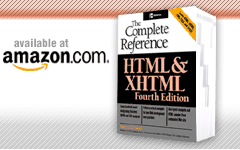rt (Ruby Text)
This initially Microsoft-specific proprietary element is used within a <ruby> tag to create ruby text, or annotations or pronunciation guides for words and phrases. The base text should be enclosed in a <ruby> tag; the annotation, enclosed in an <rt> tag, will appear as smaller text above the base text. A variation on this element is defined by XHTML 1.1.
Syntax (Defined by Microsoft)
<rt
</rt>
accesskey="key"(5)... ruby text ...
class="class name(s)"(5)
contenteditable="false | true | inherit"(5.5)
dir="ltr | rtl"(5)
disabled="false | true"(5.5)
hidefocus="true | false"(5.5)
id="unique alphanumeric identifier"(5)
lang="language code"(5)
language="javascript | jscript | vbs | vbscript | xml"(5)
name="string"(5)
style="style information"(5)
tabindex="number"(5)
title="advisory text"(5)
unselectable="on | off"(5)
</rt>
Events Defined by Internet Explorer
onactivate, onbeforedeactivate, onbeforeeditfocus, onblur, oncontrolselect, ondeactivate, ondrag, ondragend, ondragenter, ondragleave, ondragover, ondragstart, ondrop, onfocus, onmouseenter, onmouseleave, onmove, onmoveend, onmovestart, onreadystatechange, onresizeend, onresizestart, onselectstart, ontimeerror
Example
<ruby>Base Text
<rt>Ruby Text</rt>
</ruby>
Compatibility
XHTML 1.1
Internet Explorer 5, 5.5, 6
Notes
This element works only in Internet Explorer 5.0 and higher.
The rt element must be used within the ruby element.
Microsoft defines rt as an inline element that requires no closing tag; however, under the Ruby XHTML specification, it does have a close tag, so it should be used in support of the future standard being widely adopted.
At the time of this edition's writing in 2003, this element should be used only in an Internet Explorer-exclusive environment because other browsers will not interpret it or the ruby element yet, despite the rise of the Ruby module for XHTML 1.1.


